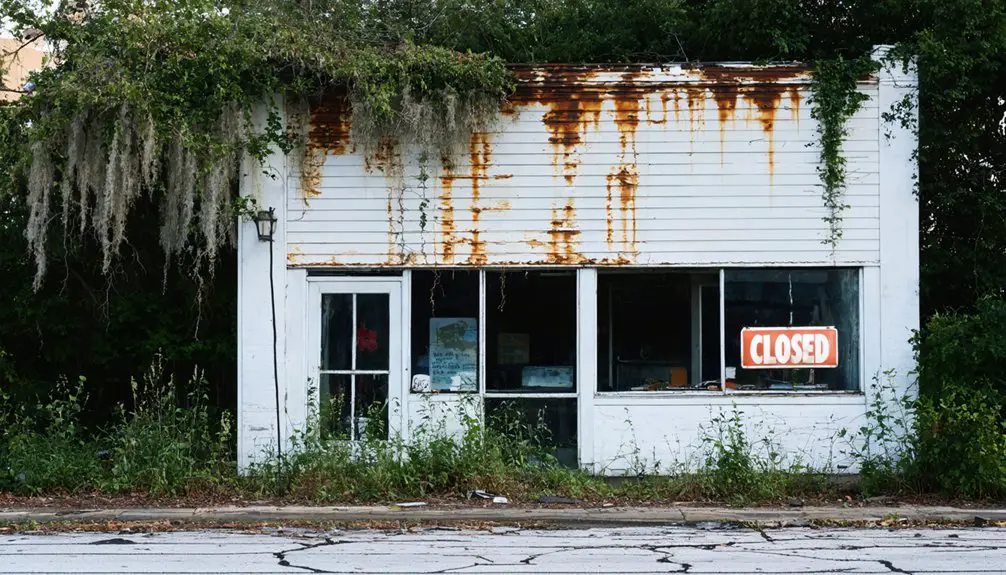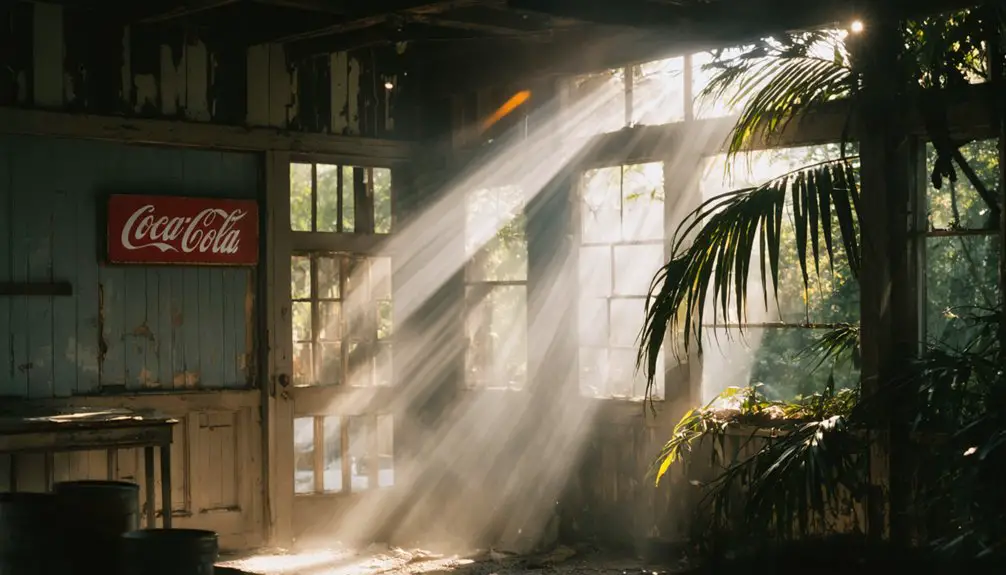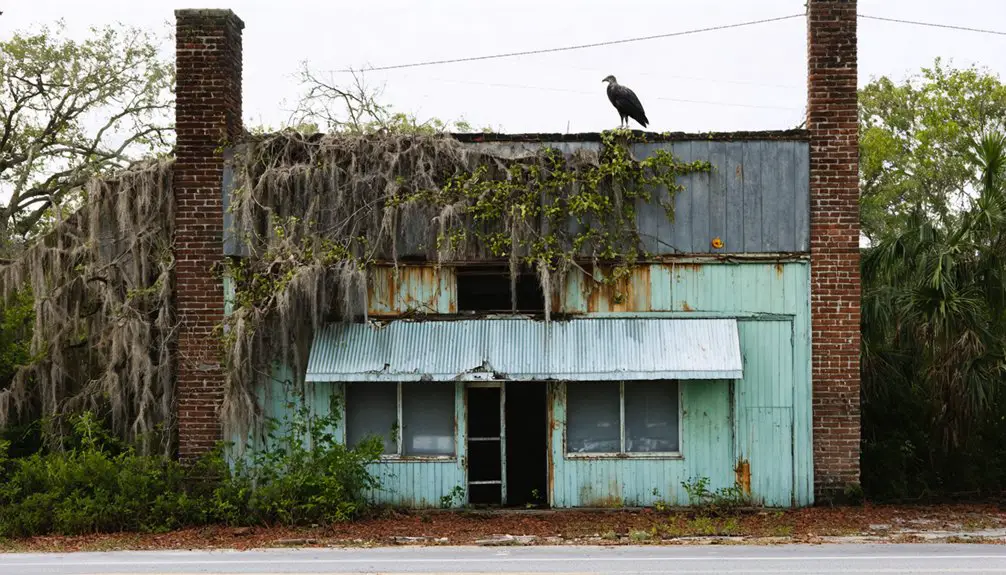You’ll find Midland’s abandoned remains between Crescent Lake and Lake Stella on Florida’s Fruitland Peninsula. This former turpentine boomtown emerged in the mid-1800s, flourishing through naval stores production and lumber operations until the early 20th century. The community thrived on lakeside traditions and steamboat commerce until depleted pine forests and shifting railroad routes led to its decline. Today’s empty pastureland holds stories of a once-vibrant settlement waiting to be discovered.
Key Takeaways
- Midland was established as a turpentine town in mid-1800s Florida, becoming a major naval stores outpost near the Aucilla River.
- The town’s economy relied heavily on logging and turpentine industries, utilizing Herty cup systems for pine resin collection.
- Located between Crescent Lake and Lake Stella, Midland fostered tight-knit communities centered around lakeside traditions and fishing.
- The town’s decline began with depleted pine forests, railroad route changes, and the devastating “Big Freeze” of 1894-1895.
- Today, Midland exists only as remains on private pastureland, transformed from a community of 144 residents to an empty ghost town.
The Rise of a Turpentine Town
As the turpentine industry migrated southward from the depleted forests of North Carolina in the mid-1800s, Midland emerged as one of Florida’s bustling naval stores outposts.
You’ll find the roots of this transformation in the vast longleaf pine forests that once dominated the region, particularly near the Aucilla River. Northern investors, recognizing the area’s potential, snatched up expansive tracts of forest land at bargain prices in the 1880s. The area became a major producer, contributing to Florida’s position as the state’s second largest industry.
The historical significance of turpentine production in Midland can’t be overstated. Workers used specialized Herty cup systems to collect valuable pine resin.
Life Between the Lakes
While Midland’s turpentine operations defined its early economy, the town’s unique position between Crescent Lake and Lake Stella on the Fruitland Peninsula shaped its cultural identity and daily rhythms.
You’d find tight-knit communities formed around lakeside traditions, with families maintaining exclusive “pie-shaped” fishing territories that yielded impressive weekly catfish harvests of up to 1,200 pounds. Local families like the Townsends would use handmade wooden boxes to store their fishing lines and equipment.
The waterways weren’t just essential for sustenance – they connected you to neighboring settlements via steamships and supported a vibrant social life. Similar to how the Florida Midland Railroad connected communities across central Florida, these water routes were vital transportation corridors.
Women’s clubs drove civic improvements, while Native American artifacts along the shores reminded you of the area’s deep historical roots.
This fishing heritage, passed down through generations of oral histories, created a unique culture where your life revolved around the rhythms of these two defining lakes.
Economic Foundations and Industry
Despite its scenic location between lakes, Midland’s economic foundation rested firmly on resource extraction, particularly logging and turpentine production.
The town’s aggressive logging practices and company store system created a tight economic grip on workers, while environmental degradation undermined long-term economic sustainability. Much like other Florida settlements, Midland became another victim of boom-bust cycles typical of resource-dependent communities. The Consolidated Naval Stores operated a major turpentine processing facility in the area until relocating in 1929.
- You’d find lumber mills dominating the landscape from the late 1920s through mid-1930s, employing most of the town’s workforce.
- Your wages would often come as scrip, forcing you to shop at the company store’s inflated prices.
- You’d witness the devastating impact of repeated mill fires, including the 1935 disaster causing nearly $1 million in modern damages.
- You’d see your town’s future dim as deforestation and resource depletion took their toll, eventually forcing families to seek opportunities elsewhere.
Daily Living in 19th Century Midland
If you’d lived in 19th century Midland, you would’ve found workers’ homes to be simple wooden structures built by the families themselves, typically surrounded by small vegetable gardens and livestock pens.
Your family’s daily activities would’ve centered around gender-specific roles, with women managing domestic tasks like cooking and sewing while men worked outdoors tending crops and livestock. During spring and summer months, families made extra income by leading tourists on steamboat excursions through nearby waterways.
You’d have spent evenings gathered with family members, sharing stories and songs passed down through generations, while weekends often involved community gatherings with neighboring settlers for both social and practical purposes. Children had limited leisure time, spending most of their day helping parents with essential chores.
Worker Housing Conditions
As workers flocked to Midland’s industrial sites in the late 19th century, they encountered housing conditions that reflected the era’s stark economic realities. The housing types available ranged from modest frame houses to basic shelters, with monthly rents between $15-22 for those fortunate enough to secure company housing.
Living conditions varied dramatically based on your status and employment, though most faced significant challenges:
- You’d find yourself in small wooden structures, typically built from pine or cypress, with front and rear porches.
- Your family would share cramped quarters with minimal privacy and sparse furnishings.
- You’d likely use outhouses or communal facilities, as indoor plumbing remained a luxury.
- You’d navigate unpaved, sandy streets while contending with Florida’s unrelenting heat and mosquitoes.
These conditions mirrored the harsh living conditions seen in workhouses of the same era, where overcrowding and poor sanitation were commonplace.
Family Social Activities
Life in 19th century Midland revolved around tightly-knit family units where work, education, and leisure intertwined seamlessly throughout each day.
You’d find mothers teaching children through oral traditions, sharing folk rhymes and stories while completing household tasks together. Family storytelling served as both entertainment and education, preserving cultural heritage across generations. Like many Florida families whose heritage stretched back to since 1799, these oral histories formed a crucial link to their ancestral roots.
Your social interactions would primarily occur within the family circle, though you’d occasionally gather with neighbors for communal gatherings tied to farming cycles or church events.
These occasions provided rare opportunities to connect beyond your immediate household. During Florida’s warm evenings, you’d often find families combining work with leisure, as mothers spun yarn while fathers taught sons essential skills, all while sharing tales that strengthened family bonds in this frontier community.
The Path to Abandonment

You’ll find that Midland’s decline began when its turpentine industry faltered due to pine forest depletion, leaving workers and their families with diminishing economic prospects.
The Florida Midland Railroad’s shifting routes and eventual operational challenges further isolated the settlement, cutting off essential transportation links that had sustained the community.
As employment opportunities dwindled and basic services became harder to maintain, Midland’s residents gradually relocated to more prosperous areas, leaving behind their modest homes and the town’s once-bustling turpentine operations.
Industry Decline Takes Hold
While Midland’s early prosperity seemed assured by its diverse economic foundations, the town’s decline began when multiple industries faltered simultaneously in the late 19th century.
The economic challenges proved too severe for the community’s resilience, as natural and market forces dealt devastating blows.
You’ll find these crucial factors sealed Midland’s fate:
- The “Big Freeze” of 1894-1895 decimated local citrus operations, destroying a critical economic pillar.
- Timber resources rapidly depleted from intensive logging, leaving mills without raw materials.
- Turpentine extraction damaged the surrounding pine forests, making them commercially unviable.
- Post-Great Depression market shifts reduced demand for local goods, crippling remaining businesses.
The town’s workforce soon dispersed to urban centers, leaving behind empty storefronts and silent mills that once bustled with activity.
Railroad Economics Impact Settlement
The railroad’s influence on Midland’s destiny began long before the town’s economic collapse, tracing back to the Florida Midland Railway Company’s incorporation in 1883.
You’ll find the town’s very existence hinged on railroad infrastructure, which promised essential freight transportation connections between Lake Jessup and Leesburg.
While early prosperity seemed assured through a mix of local and Boston investment capital, you can trace Midland’s vulnerability to its narrow economic foundation.
The railroad’s east-west route initially attracted sawmills and timber operations, but when logging depleted nearby resources, freight volume plummeted.
You’re seeing a classic case of boom-and-bust economics – as rail service became unsustainable, the town’s isolation grew.
Without reliable transportation access, Midland’s businesses couldn’t reach broader markets, accelerating the settlement’s decline toward ghost town status.
Population Exodus Patterns
As environmental and economic pressures mounted in the late 1800s, Midland’s population decline followed a predictable pattern seen in other central Florida ghost towns.
The demographic shifts began with younger residents seeking opportunities in growing urban centers, while elderly community members held on longer despite diminishing services.
Key migration motivations that drove Midland’s exodus:
- The devastating “Big Freeze” of 1894-1895 crippled local agriculture and economic stability.
- Closure of essential businesses and services created a snowballing effect of departures.
- Infrastructure deterioration made daily life increasingly difficult for remaining residents.
- Loss of community institutions like churches and schools severed social bonds.
You’ll find that once this cycle began, declining property values and reduced tax revenue accelerated Midland’s transformation from a struggling town to abandonment.
Historical Legacy and Present Day

Modern visitors searching for Midland’s remains will find little evidence of this once-thriving turpentine town, now situated on private pastureland between Crooked Lake and Lake Buffum.
Historical documentation, including marriage certificates from 1888 and family records, provides vital insights into this vanished community’s legacy.
You’ll discover that ghost town preservation efforts have helped maintain Midland’s story through local heritage organizations, even as its physical structures have disappeared.
The town’s transformation from a bustling settlement of 24 houses and roughly 144 residents to empty pastureland reflects the broader pattern of resource-dependent communities in Central Florida.
Today, you’ll need landowner permission to explore the site, where few tombstones remained by 1974, and virtually no original structures stand to mark this piece of Florida’s turpentine industry history.
Frequently Asked Questions
Are There Any Remaining Structures or Ruins Visible in Midland Today?
You won’t find any remaining buildings clearly visible today, and while locals occasionally report ghostly sightings, there’s no documented evidence of intact structures amid Florida’s thick vegetation and development.
What Native American Tribes Originally Inhabited the Midland Area?
You’ll find Timucua tribes were the earliest documented indigenous culture in this central region, though later Seminole groups, formed from Creek migrants, also established significant presence around this territory.
Did Any Notable Historical Figures Ever Visit or Live in Midland?
You won’t find records of any famous visitors in Midland’s history. Its historical significance remained local, centered on settler families like the Stokes and Rhodens working in the turpentine industry.
Were There Any Significant Natural Disasters That Affected Midland’s Development?
While millions of natural disasters struck Florida’s coast, you won’t find records of significant hurricane impact or flood damage affecting this inland settlement. Historical documents suggest economic and railroad changes drove its decline.
What Happened to the Families Who Lived in Midland After Abandonment?
You’ll find Midland families dispersed to nearby Florida towns, seeking agricultural and logging opportunities, while maintaining kinship networks. Their Midland legacy persists through oral histories and surviving family names regionally.
References
- https://www.ghosttowns.com/states/fl/midland.html
- https://en.wikipedia.org/wiki/List_of_ghost_towns_in_Florida
- https://citruslandfl.blogspot.com/2016/07/towns-of-florida-midland-railroad.html
- https://www.wikiwand.com/en/articles/List_of_ghost_towns_in_Florida
- https://www.goodreads.com/topic/show/18559373-creston-of-orange-county
- https://woodbarter.com/threads/a-sticky-situation-the-turpentine-industry-in-north-florida.39742/
- https://ecbpublishing.com/the-turpentine-era/
- https://dunnhistory.com/the-brutality-of-floridas-turpentine-industry/
- https://lflank.wordpress.com/2023/11/14/floridas-turpentine-industry/
- https://www.srs.fs.usda.gov/pubs/gtr/gtr_srs240.pdf



